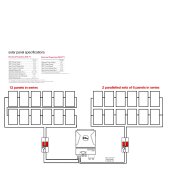Survival_Research
New Member
- Joined
- Nov 19, 2022
- Messages
- 5
In the following diagram I list the specs for the 24 panels I have.
My question is among the many different voltages listed and the various current specs listed, exactly which one would I use to calculate the total voltage and current for each of the two examples of wiring, on the left, a series wiring of all 12 panels in one circuit and the other wiring example on the right hand side being two paralleled 6 panel series wired circuit.
If someone can just type out the formula for each I would be grateful for that.
Thanks
My question is among the many different voltages listed and the various current specs listed, exactly which one would I use to calculate the total voltage and current for each of the two examples of wiring, on the left, a series wiring of all 12 panels in one circuit and the other wiring example on the right hand side being two paralleled 6 panel series wired circuit.
If someone can just type out the formula for each I would be grateful for that.
Thanks



